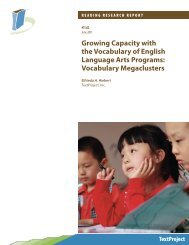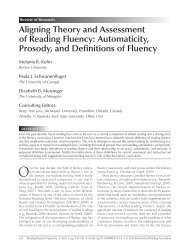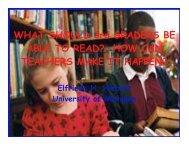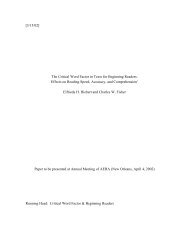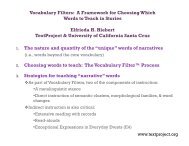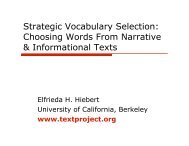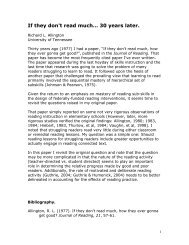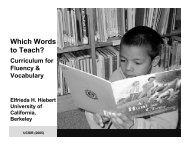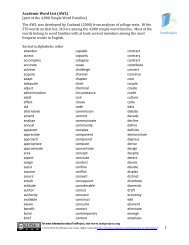Relations Between the CCSS and RTI in Literacy and Language
Relations Between the CCSS and RTI in Literacy and Language
Relations Between the CCSS and RTI in Literacy and Language
Create successful ePaper yourself
Turn your PDF publications into a flip-book with our unique Google optimized e-Paper software.
388RELATIONS BETWEEN THE <strong>CCSS</strong> AND <strong>RTI</strong> IN LITERACY AND LANGUAGEstudents. Because <strong>the</strong> <strong>CCSS</strong> willdirect <strong>the</strong> content of <strong>the</strong> curriculum,<strong>in</strong>struction, <strong>and</strong> assessment <strong>in</strong> ELAfor students <strong>in</strong> at least <strong>the</strong> 45+ statesthat have adopted <strong>the</strong>m, <strong>the</strong>y will mostcerta<strong>in</strong>ly have a significant impact on<strong>in</strong>struction <strong>and</strong> <strong>in</strong>tervention with<strong>in</strong> an<strong>RTI</strong> approach to teach<strong>in</strong>g <strong>and</strong> learn<strong>in</strong>g.This column explores <strong>the</strong> implicationsof <strong>the</strong> <strong>CCSS</strong>-ELA for <strong>RTI</strong> <strong>in</strong> <strong>the</strong> areas ofliteracy <strong>and</strong> language.BackgroundThe <strong>CCSS</strong>, like most academic contentst<strong>and</strong>ards, are designed to provide aconsistent, clear underst<strong>and</strong><strong>in</strong>g of whatstudents are expected to learn. They aredesigned to be robust <strong>and</strong> relevant to<strong>the</strong> real world, reflect<strong>in</strong>g <strong>the</strong> knowledge<strong>and</strong> skills that our young people needfor success <strong>in</strong> college <strong>and</strong> careers. Theconcept of college <strong>and</strong> career read<strong>in</strong>essis a driv<strong>in</strong>g force beh<strong>in</strong>d <strong>the</strong> <strong>CCSS</strong>.College <strong>and</strong> Career Read<strong>in</strong>ess (CCR)st<strong>and</strong>ards for <strong>the</strong> end of 12th gradewere developed first. These CCRst<strong>and</strong>ards <strong>the</strong>n served as <strong>the</strong> basis for<strong>the</strong> development of <strong>the</strong> k<strong>in</strong>dergartenthrough grade 12 (K–12) st<strong>and</strong>ards,which are <strong>in</strong>tended to function aslearn<strong>in</strong>g progressions that lead toachievement of <strong>the</strong>CCR st<strong>and</strong>ards.The <strong>CCSS</strong>-ELA provide an<strong>in</strong>tegrated view ofliteracy <strong>and</strong> language,highlight<strong>in</strong>g <strong>the</strong> areaswith<strong>in</strong> <strong>the</strong> ELA—read<strong>in</strong>g, writ<strong>in</strong>g,speak<strong>in</strong>g/listen<strong>in</strong>g,<strong>and</strong> language. ForK–5, <strong>the</strong> read<strong>in</strong>g <strong>and</strong>writ<strong>in</strong>g str<strong>and</strong>s arefur<strong>the</strong>r del<strong>in</strong>eated bytext type—literature<strong>and</strong> <strong>in</strong>formational.The grade 6–12st<strong>and</strong>ards are first organized by ELA<strong>and</strong> subject matter to dist<strong>in</strong>guishwhich st<strong>and</strong>ards are <strong>the</strong> responsibilityof <strong>the</strong> ELA teacher <strong>and</strong> which are tobe addressed by subject area teachers.With<strong>in</strong> <strong>the</strong> ELA portion of <strong>the</strong> grade6–12 st<strong>and</strong>ards, <strong>the</strong> organization issimilar to that of <strong>the</strong> K–5 st<strong>and</strong>ards(i.e., all four areas of <strong>the</strong> languagearts, with read<strong>in</strong>g <strong>and</strong> writ<strong>in</strong>g brokendown by literature <strong>and</strong> <strong>in</strong>formational).In contrast, <strong>the</strong> subject area sectionsaddress only read<strong>in</strong>g <strong>and</strong> writ<strong>in</strong>g, <strong>and</strong><strong>the</strong>se areas are broken down accord<strong>in</strong>gto history/social studies <strong>and</strong> science/technical subjects.<strong>RTI</strong> is focused on determ<strong>in</strong><strong>in</strong>gwhe<strong>the</strong>r students are respond<strong>in</strong>gto <strong>in</strong>struction <strong>and</strong> <strong>in</strong>tervention <strong>in</strong>a manner that <strong>in</strong>dicates <strong>the</strong>y arega<strong>in</strong><strong>in</strong>g <strong>the</strong> knowledge <strong>and</strong> skillscharacteristic of mature, effectivereaders. The <strong>CCSS</strong>-ELA documentdescribes mature, effective readers <strong>in</strong><strong>the</strong> form of a “vision” of what it meansto be literate <strong>in</strong> <strong>the</strong> 21st century (p. 3)<strong>and</strong> a “portrait” of what students whoare college <strong>and</strong> career ready <strong>in</strong> ELA“look like” (p. 7). The vision statementemphasizes that students who meet <strong>the</strong>ELA st<strong>and</strong>ards “readily undertake <strong>the</strong>close, attentive read<strong>in</strong>g that is at <strong>the</strong>heart of underst<strong>and</strong><strong>in</strong>g <strong>and</strong> enjoy<strong>in</strong>gcomplex” texts, <strong>and</strong> “habitually perform<strong>the</strong> critical read<strong>in</strong>g necessary to pickcarefully through <strong>the</strong> stagger<strong>in</strong>gamount of <strong>in</strong>formation availabletoday.” Fur<strong>the</strong>rmore, “<strong>the</strong>y activelyseek <strong>the</strong> wide, deep, <strong>and</strong> thoughtfulengagement with high-quality literary<strong>and</strong> <strong>in</strong>formational texts that buildsknowledge, enlarges experience, <strong>and</strong>broadens world views.”The portrait of students who meet <strong>the</strong>St<strong>and</strong>ards <strong>in</strong>cludes several attributescommonly identified as good habits<strong>in</strong> <strong>the</strong> areas of ELA—attributes suchas (a) demonstrat<strong>in</strong>g <strong>in</strong>dependence;(b) build<strong>in</strong>g strong content knowledge;(c) respond<strong>in</strong>g to <strong>the</strong> vary<strong>in</strong>gdem<strong>and</strong>s of audience, task, purpose,<strong>and</strong> discipl<strong>in</strong>e; (d) comprehend<strong>in</strong>g aswell as critiqu<strong>in</strong>g; (e) valu<strong>in</strong>g evidence;(f) us<strong>in</strong>g technology <strong>and</strong> digitalmedia; <strong>and</strong> (g) underst<strong>and</strong><strong>in</strong>g o<strong>the</strong>rperspectives <strong>and</strong> cultures. In short,<strong>the</strong> emphasis on college <strong>and</strong> careerread<strong>in</strong>ess <strong>in</strong> <strong>the</strong> <strong>CCSS</strong>-ELA raises <strong>the</strong>bar for what students are expected to“Because <strong>the</strong> <strong>CCSS</strong> will direct <strong>the</strong> content of<strong>the</strong> curriculum, <strong>in</strong>struction, <strong>and</strong> assessment <strong>in</strong>ELA...<strong>the</strong>y will most certa<strong>in</strong>ly have a significantimpact on...an <strong>RTI</strong> approach.”R TThe Read<strong>in</strong>g Teacher Vol. 65 Issue 6 March 2012




